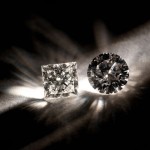Gem of the Month: Canadian Diamonds
Published
Categories
Author
Blog Post
Posting by Brendt Hyde, Mineralogy Technician
The discovery of diamonds in the 1990’s marked a beginning for Canada’s first diamond mine, the Ekati Diamond Mine, located in the Northwest Territories. It also marked the beginning of the, still relatively young, diamond mining industry in Canada.
Before we look at Canadian diamonds specifically, let’s look at where diamonds come from in general. Diamonds form under extremely high pressures below the Earth’s crust in an area called the Earth’s mantle. Carbon at these depths is most structurally stable in the form of diamond. Occasionally, this mantle material finds its way through cracks in the crust and, as it begins to rise, pressure decreases allowing volcanic gases to explosively push the material through to the Earth’s surface – Very similar to popping the cork on a champagne bottle, allowing a torrent of bubbles to spring forth. This material solidifies to form a feature referred to as a kimberlite pipe, which is composed of a rock named kimberlite.
In order to find diamonds (in most cases) you must find kimberlite. This is done in a number of ways. One way is to look for indicator minerals that are found in kimberlite including garnet – which you can see in the Gem and Gold Gallery, Teck Suite of Galleries: Earth Treasures. Scientists can also look for magnetic signatures that suggest a kimberlite pipe is present. Efforts at the Ekati Diamond Mine lead to the discovery of more than 100 kimberlite pipes. The total number of known kimberlite pipes in all of Canada has grown to over 500.
Serious diamond exploration in Canada began in the 1960’s, but significant kimberlite finds didn’t occur until the 1980’s and 1990’s. Canadian kimberlites are mostly found in harsh terrain and often found beneath lakes. Locating the first kimberlite pipes proved difficult in Canada. However, the exploration, discovery, mining and processing of diamonds has exploded in the last two decades. In a very short period of time Canada has become a world player in the diamond industry. Toronto itself also has connections to the diamond industry. Notably, it is home to the Harry Winston Diamond Corporation. A company that holds interest in the Diavik Diamond Mine, also found in the Northwest Territories. If the name Harry Winston sounds familiar, perhaps you remember seeing Harry Winston jewelry on the red carpet. Loaned high-dollar jewelry from Harry Winston has graced many award shows. You may also recognize this name as the donor of the spectacular Hope diamond to the Smithsonian.
All of these Canadian connections are interesting, but you might be asking yourself “So what’s so great about Canadian diamonds anyway?”. Well one thing that makes Canadian diamonds unique is that they were the first diamonds to be branded according to their origin. This means that if you buy a diamond branded as “Canadian” you can be pretty certain of where it came from. Branding often consists of laser inscribed drawings of Canadian logos such as polar bears, snowflakes and beavers. National pride isn’t the only reason to purchase Canadian diamonds. Many buyers see Canadian inscribed diamonds as being “conflict free” and feel better about where their diamond has come from and how it was mined. Others enjoy being able to point to map and say “hey that’s exactly where my diamond came from” and they have the documentation to prove it.
Canada’s history in the diamond industry has been short, but it has definitely been sweet.


